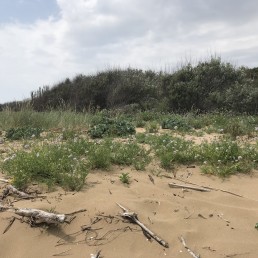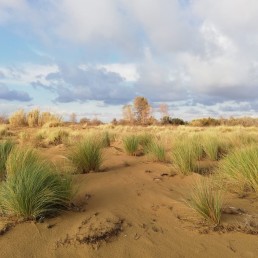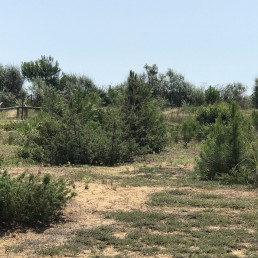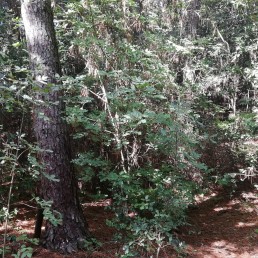
HABITAT 2110 - EMBRYONIC SHIFTING DUNES
Sparse and disjointed habitat, which colonises the first sandy mounds or “embryodunes”.
The habitat is more widespread in the Mediterranean biogeographical region, in Veneto it covers a total of c. 8 ha, concentrated in the project sites (0.5 ha in IT3250003 “Penisola del Cavallino: coastal biotopes”, 7.5 ha in IT3250033 “Laguna di Caorle – Foce del Tagliamento “). In both cases, it has a very disaggregated and fragmented distribution, located in an atypical position with respect to the normal psammophile sequence and frequently in intermingling mosaics with habitats 1210 and above all 2120.
Pressures that push on the project sites’ habitats: mainly related to recreational beach activities, in particular trampling and sand removal, for levelling and the mechanical cleaning of the beaches. The habitat is also threatened by erosion, with a contraction of the dunal systems, and consequent degradation and/or simplification of the community.
Conservation status at national level (Continental biogeographical region): BAD (U2), stable trend (ISPRA, 194/2014)

HABITAT 2120 - SHIFTING DUNES OF THE SHORELINE WITH THE PRESENCE OF AMMOPHILA ARENARIA (WHITE DUNES)
Conservation status at national level (Continental biogeographical region): BAD (U2), stable trend (ISPRA, 194/2014)
Habitat represented by disjointed plant-covered dunes formed by tufts of Ammophila arenaria, the main responsible for the sand accumulation process and for the formation of the dune bars. In Veneto, this habitat has a surface of a little less than 40 ha, of which approximately 35% is in the project areas (3.7 in IT3250003 “Peninsula of Cavallino: coastal biotopes”, 3.3 ha in IT3250013 “Laguna del Mort and Pinete di Eraclea”, 6.6 ha in IT3250033 “laguna di Caorle – Foce del Tagliamento”).
Pressures that push on the project sites’ habitats: on the project sites, the habitat is well represented, sometimes even with extensive and deep formations, but in most cases, as an effect of excessive trampling, it is fragmented and mosaicked with 2110. The main threat factors affecting the habitat are the same as for habitat 2110 and are connected to recreational beach activities. The habitat is also threatened by the invasion of exotic species whose dissemination is favoured by trampling.

HABITAT 2130* - FIXED COASTAL DUNES WITH HERBACEOUS VEGETATION (GREY DUNES)
Conservation status at national level (Continental biogeographical region): BAD (U2), negative trend (ISPRA, 194/2014)
Priority habitat, mainly Boreo-Atlantic distribution, has a small enclave in Italy, located exclusively in the northern part of the Adriatic basin (regions Veneto, Friuli Venezia Giulia and Emilia Romagna). In Veneto, it has a total surface of about 99 ha, 87% concentrated on the project sites (10 ha in IT3250003 “Peninsula del Cavallino: coastal biotopes”, 10 ha in IT3250013 “Laguna del Mort and Pinete di Eraclea”, 62 ha in IT3250033 “Laguna di Caorle – Foce del Tagliamento”, 4,6 ha in IT3250032 “Bosco Nordio”). As part of the edafo-xerophilous series, it represents the community with the highest wealth of species, including Stipa veneta* and the endemic Centaurea tommasinii (NT at regional level). It is represented by an endemic community, characterised by a complex structure that contributes moss, lichen and higher plants, particularly small shrubs.
Pressures that push on the project sites’ habitats: it is one of the most threatened coastal habitat beaciuse of tourism (summer sports, trampling, driving vehicles) and in many areas its structure an composition have been strongly altered. Trampling leads to habitat destructuring, with the development of therophytic substitution and the invasion of alien species. The particular location of the habitat, which sometimes occupies clearings in woods, also makes it particularly vulnerable to invasion by young specimens of Pinus sp. or other shrubs.

HABITAT 2250* - DUNES WITH JUNIPERUS SPP
Conservation status at national level (Continental biogeographical region): Favourable (FV), trend Stable (ISPRA, 194/2014)
mantle and premantle that develop on the stabilized dunes. In the strictly Mediterranean area,
the habitat is dominated by Juniperus oxycedrus ssp. macrocarpa, sometimes associated with Juniperus phoenicea ssp. turbinata; along the high Adriatic arc, develops a particular facies of the habitat, represented from an endemic community, dominated by Juniperus communis. It normally forms small nuclei, often mosaic with 2130* and 2270*, of limited extension and often linear development. In Veneto it has a mapped surface of 1,06 ha entirely included in the project sites (0,04 ha in IT3250003
“Penisola del Cavallino: coastal biotopes”, 0.77 ha in IT3250033 “Laguna di Caorle – Foce del
Tagliamento”
Pressures that push on the project sites’ habitats: habitat, in the past more represented, but actually in strong regression due to excessive forest density and the impact related to the use of the dune for
recreational activities. Currently it is limited to very few niches un- or little-exploited for tourist or residential purposes.

HABITAT 2270* - DUNES WITH PINUS PINEA AND /OR PINUS PINASTER FORESTS
Conservation status at national level (Continental biogeographical region): Favourable (FV), trend Stable (ISPRA, 194/2014)
Predominant habitats in the Mediterranean biogeography region. In Veneto, it has a total surface area of 256 ha, including 89% in project sites (33 ha in IT3250003 “Peninsula del Cavallino: coastal biotopes”; 30 ha in IT3250013 “Laguna del Mort and Pinete di Eraclea”; 148 ha in IT3250033 “Laguna di Caorle – Foce del Tagliamento”, 16 ha in IT3250032 “Bosco Nordio”; 16 ha in IT3250032 “Bosco Nordio”) (data from www.regione.veneto.it and Buffa G Lasen & C. 2010). It is represented by formations to Pinus pinea and P. pinaster that occupies the most internal and stable dune sector. These are mostly populations deriving from, often dense and monospecific, reforestation characterised by a severe lack of plant species. Where there are natural or induced processes to reconstitute the original mantle, and in the lower-density sections, the pinewood is enriched with species from the surrounding natural vegetation, assuming the characteristics that allow it to be given priority.
Pressures that push on the project sites’ habitats: the main threat factors are linked to the natural dynamics of pinewood that lead to populations being constituted with too high of a density, which leads to the deterioration of the dominant and spoilage layers for phytopathological reasons. Other pressures are linked to tourist use and the waste being left which causes an increase in soil trophicity.


